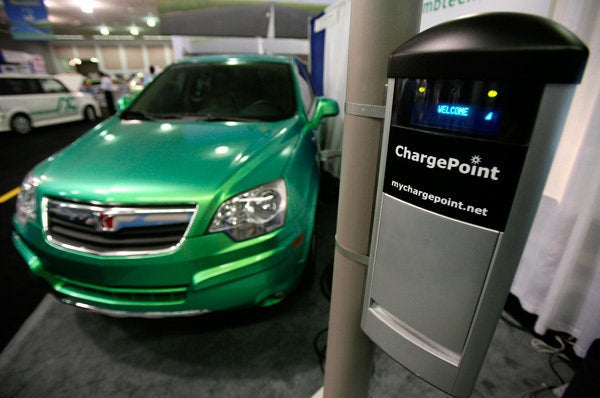
For many people, Tesla's electric Roadster redefined the whole concept of sustainable mobility. Electric cars weren't supposed to be sleek and sporty, with acceleration that rivaled Porsches and Ferraris. They were supposed to be virtuous eco-rides--sober extensions of the Prius paradigm. They certainly weren't supposed to be designed and built for ultra-affluent environmentalists who had $109,000 burning a hole in their carbon footprint.
Tesla Motors challenged assumptions and produced a car that had emotional oomph aplenty. That made electric vehicles seem incredibly cool. The press ate it up. Celebrities plunked down deposits to take delivery of the first models.
That's why last week's news that the startup carmaker would lay off half its work force and delay the already delayed delivery of more than a thousand pre-ordered Roadsters was, at one level, depressing. Even as youthful Chairman Elon Musk slipped in to the CEO's chair, the flashiest name in electric vehicles was beginning to looks as if it was going under.
But even though the downfall of Tesla seems like a disaster for boosters of all-electric vehicles, it should be a welcome development for the green-transportation movement. Tesla symbolized a science-fiction view of our future: it seemed like an instant cure for the problems of oil consumption and greenhouse emissions. In reality, it was a well-marketed distraction from a strategy that would yield more immediate results.
Don't get me wrong--vehicles that run entirely on electricity, conveniently drawn from the existing power grid, should be a component of any plan to achieve sustainable mobility. But with capital increasingly tight at the moment, and with the federal government facing an unprecedented challenge given the sheer size of the financial crisis, we need to put environmental dollars where they can do the most good, right now.
Tesla Motors has always represented an idiosyncratic, romantic chapter in the history of electric vehicles, which have been around as long as cars propelled by internal combustion engines. The big knock on electrics was always that they lacked the range of IC-powered cars. Then Tesla came along and not only unveiled a vehicle that could travel hundreds of miles on a single charge, but that could do 0-60 in four seconds. The gorgeous two-seater design, provided by Lotus and crafted in exotic carbon fiber, also didn't hurt.
Tesla's for the middle-class were on the way: a sedan priced in the BMW/Audi range, and a versatile crossover, which would sell for substantially less. A $250 million plant was announced for San Jose, CA. All is now in doubt, as Tesla appears to have been nailed by the credit crunch and manufacturing problems. This is all happening as both GM and Chrysler have rolled out their own less expensive electric cars, and as Toyota is ramping up development of so-called plug-in hybrid vehicles.
This is where we should direct our efforts: the less glamorous proposition of getting fuel-efficient, environmentally friendly vehicles in the driveways of as many people as possible. The big Detroit carmakers, even with their current struggles, and the automakers of Japan and Europe already have the manufacturing capability to shift a majority of their production over to clean diesel, gas-electric hybrids, and plug-in hybrids.
Tesla has tried to distinguish itself from the traditional carmakers by espousing a Silicon Valley attitude toward its mission. See the car not as a car, but as a technological product. Advocate sweeping, rather than incremental, solutions. Musk himself described Tesla's new service center in Los Angeles as being modeled after the Apple Store. It was a neat trick, this attempt to reinvent the great American car as a planet-saving ticket to exhilaration that jettisoned all that grimy old dirty fingernails under-the-hood stuff.
At base, however, the dream was impractical. We'll all be driving electric vehicles some day, because we'll eventually run out of oil. But by trying to force the timetable on electrics, we're not doing ourselves any favors. And now that capital is scarce, we need to stop wasting it on quixotic undertakings. Tesla shouldn't receive anymore financing, and the celebs who ordered Roadsters should ask for their money back.
Tesla won't have been a total loss. It proved that battery technology could power a car that's both fast and has decent range. Battery R&D should form a significant component of our overall sustainable mobility project. Better, cheaper, smaller batteries means hybrids that achieve higher and higher mileage and emissions standards--and that will eventually allow the IC engine to be phased out. By then, we will be fueling mobility not with oil, but with new nuclear reactors, solar and wind power, and perhaps a few electricity generating technologies not yet invented. That will be the time for the electric car to finally come online and assume its rightful role.
UPDATE: Darryl Siry, Tesla's Marketing VP, corrected some facts and confirmed some new information. Total layoffs now amount to 16%, and may rise to 20% by the end of the year. As reported by Reuters, the company has $9 million on hand and is seeking and additional $20 million. As for delays: Siry says that the Roadster's model year and production year are current out of sync. Pre-orders of the 2008 model are 600 vehicles, of which 50 have been delivered so far. He said Tesla hopes to satisfy the 2008 orders by next June and get the model year back in sync for 2009.